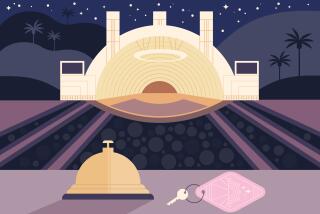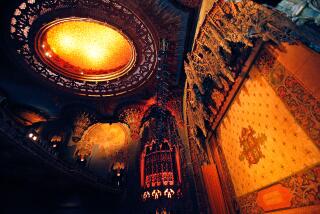So Long, Whiskey Gulch
- Share via
At first glance, East Palo Alto seems an odd choice for a new Four Seasons luxury hotel, especially when it’s right on top of a freeway. Come to think of it, it seems pretty odd at second glance, too.
After all, East Palo Alto is a world away--even though it’s just a block away--from Palo Alto, home of Stanford University and the birthplace of countless start-ups and venture capital firms that fueled the dot-com engine.
Barely touched by the area’s technology boom, low-income and primarily minority, East Palo Alto hasn’t gotten much press, except back in 1993, when it made national news as the city with the highest per capita murder rate. For a long time, the best-known part of East Palo Alto was Whiskey Gulch, a seedy strip of dive bars, liquor stores and run-down apartment buildings known for drug sales and gang violence. The name harkens back to the early days of Stanford, then a “dry” school with alcohol sales not permitted within Palo Alto. The only things that separated Whiskey Gulch from the tree-lined, mansion-studded streets of Palo Alto’s most expensive residential areas were a small creek and a drab curve of freeway.
“Ugh,” recalls Dee Armstrong, a high-tech veteran. “I used to avoid taking that exit when I had the kids in the car.”
Well, goodbye Whiskey Gulch, hello Four Seasons.
Thanks to an energetic and so far quite successful redevelopment campaign by the city of East Palo Alto, the Gulch is getting a makeover, though it’s not without its oddities. The hotel, which opened in January, stands in the swanky new University Circle office complex and is probably the only Four Seasons in the world where guests can haul purchases from a neighboring IKEA back to their room simply by wheeling them across a freeway overpass.
Before the hotel opened, location wasn’t the only factor behind the raised eyebrows and skeptical smiles. The ambitious University Circle project, which promised to add 450,000 square feet of new office space, got started back in 1998, when the Internet economy was exploding and square footage was being snapped up as quickly as it came on the market. By the time construction was underway, however, the bubble had burst and floor after floor in office parks up and down Silicon Valley had turned into see-throughs. Those who drove by on the 101 and realized that a Four Seasons was going in could only shake their heads over the evident miscalculation.
What lesson is to be drawn, then, from the fact that University Circle is almost completely leased out, and to high-end brokerage and law firms such as Wachovia Securities, Dewey Ballantine and Bingham McCutchen--exactly the sort of companies whose visiting partners and clients would want to stay at, well, a Four Seasons?
Really, it’s a simple one: Despite all the high-tech execs who’ve taken a tumble in recent years, there’s still an awful lot of money sloshing around the valley. And the area, even though it has lost some luster, has long been starved for a top-notch, name-brand hotel.
Until the Four Seasons opened, business travelers basically were held hostage by the small, boutique-y Garden Court Hotel in downtown Palo Alto or Menlo Park’s grandmotherly Stanford Park Hotel. “I used to send people to the Garden Court,” says John Murray, a managing director at San Francisco boutique investment bank Savvian, who stopped by the new Four Seasons for breakfast with a CEO friend to check out the place. “But everyone gets the corporate discount for Four Seasons. It will be the de facto place to stay.”
For many, it already is. On a recent day, slick, eager young men chatted in twos and threes in the lobby, waiting for a new, hot start-up’s breakfast to begin in one of the meeting rooms. Another man strode to the checkout counter, his Louis Vuitton garment bag over his shoulder. Robert Whitfield, the hotel’s general manager, says that the place is almost sold out during the week, although he admits, “Thursday afternoon you feel the place change.” This is clearly a business hotel.
And it’s a nice one, having managed to turn its biggest disadvantage--being right on top of the 101--into something special: Step off the elevator on any guest floor and you’re greeted by a long corner of glass where you expect solid wall. The view is wonderful: sparkling city lights and silent speeding cars below. “We knew we could do it,” says Peter Hodgson, the Four Seasons’ vice president of corporate planning. “We have a great hotel in Tokyo right by a station where all the bullet trains come in. The sound mitigation technology nowadays is very good.”
Still, here in East Palo Alto, you can hear a couple of things if you listen closely enough. One is the hum of money being spent. A regular room at the Four Seasons goes for $325, though they’ll give it to you for $295 if you say “business” when the reservations clerk asks, “Business or pleasure?” (At the ultra-polite Four Seasons, no one asks for proof.) The room rate is expected to climb to $400-plus, Four Seasons officials say, as the hotel establishes itself.
The other sound from East Palo Alto is that of cool self-satisfaction. Across the way, Menlo Park residents have long bragged about putting the kibosh on a possible hotel on Sand Hill Road, the area’s famed venture-capital corridor, back in the ‘80s. It was a NIMBY thing. Now, however, the city could use the occupancy-tax revenue, and there is talk--confident talk--that Rosewood Hotels & Resorts, best known for the Mansion on Turtle Creek in Dallas, will break ground on Sand Hill in the coming months. Rosewood has even hired the same architects that designed the East Palo Alto Four Seasons.
Whitfield just shrugs. “We’re open,” he says. “They’re still waiting for approval.”
More to Read
Sign up for The Wild
We’ll help you find the best places to hike, bike and run, as well as the perfect silent spots for meditation and yoga.
You may occasionally receive promotional content from the Los Angeles Times.






